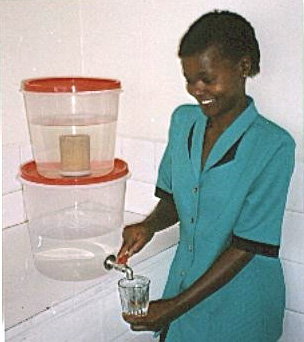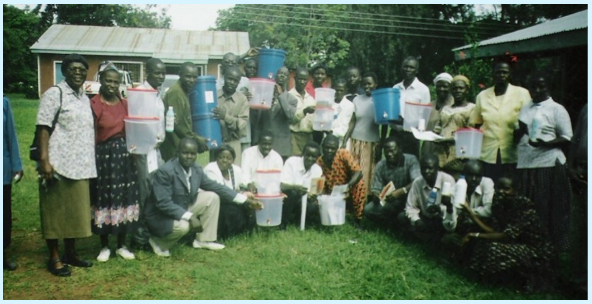Difference between revisions of "Kisii filter bucket"
| Line 10: | Line 10: | ||
The upper bucket has a “standard” (normally available on the market) ceramic filter, the filtered water drips into the lower PVC bucket and can be used with a small tap. The lower bucket is well closed for safe storage. | The upper bucket has a “standard” (normally available on the market) ceramic filter, the filtered water drips into the lower PVC bucket and can be used with a small tap. The lower bucket is well closed for safe storage. | ||
| + | |||
| + | ==Suitable conditions== | ||
| + | {{procontable | pro= | ||
| + | - Safe and clean water in sufficient quantities is always available at home. <br> | ||
| + | - Due to the low cost, safe water now becomes available for a large group of people. <br> | ||
| + | - Good amount of household storage, less cumbersome than a clay pot. <br> | ||
| + | - Cost savings: since no need to boil water, money is saved on charcoal and other energy sources.<br> | ||
| + | - Efficient: since it comes from a tap, people only take the exact amount they need.<br> | ||
| + | - Safer for children, who do not have to scoop water from a clay pot. Instead, the hygienic tap is used.<br> | ||
| + | - Forests are conserved, as firewood is not needed to boil water. | ||
| + | | con= | ||
| + | }} | ||
==Construction, operations and maintenance== | ==Construction, operations and maintenance== | ||
Revision as of 00:38, 4 July 2012
| |
The Kisii Filter bucket has been developed in collaboration with the Rural Water Development (RWD) Project in Kisii, Western Kenya in 2003, as a response to the low quality of household water and water from springs and wells in that area.
This low cost technology was also very much appreciated in Nairobi, where most people boil the water from the tap. The Kisii bucket has become increasingly popular, as well in the rural areas as in the towns were people have water from the tap and many NGOs are now also promoting this simple system.
The specific idea of the “Kisii Filter Bucket” is to use low cost transparent PVC containers with a ceramic filter to compose a water filter system.
The upper bucket has a “standard” (normally available on the market) ceramic filter, the filtered water drips into the lower PVC bucket and can be used with a small tap. The lower bucket is well closed for safe storage.
Contents
Suitable conditions
| Advantages | Disadvantages/limitations |
|---|---|
| - Safe and clean water in sufficient quantities is always available at home. - Due to the low cost, safe water now becomes available for a large group of people. |
Construction, operations and maintenance
The filter system needs only a minimum of maintenance (regular cleaning of the outside of the ceramic element and inspection and cleaning of the inside of the buckets). The filter candle can be used for six month up to several years, depending on the quality of the water to be filtered.
Two types of ceramic filters candles are recommended:
- A “slow speed” ceramic filter candle, made in India, costs about 1 US$ (in local shops) and can filter 3 litres of water per day. This candle can be impregnated with silver for additional security.
- A “high speed” filter, with additional silver and active carbon already inside, made in Brazil, costs about 3US$ and can produce 25 litres of safe water per day.
The filter bucket is transparent. Users can see how much water is present both in the filter unit and in the lower storage unit. It also is directly visible when the filter candle needs to be cleaned. This improves trust and a better management of the available water in the household.
Reference manuals, videos, and links
- Video demonstration: Kisii waterfilter.
Acknowledgements
- Kisii filter bucket. Rural Water Development (RWD) Project.


